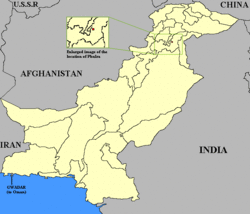Phulra
| Phulra | |||||
| Princely state of Pakistan | |||||
| |||||
 | |||||
| Capital | Phulra | ||||
| History | |||||
| • | Established | 1828 | |||
| • | Disestablished | 1950 | |||
| Area | 98 km2 (38 sq mi) | ||||
| Today part of | Khyber Pakhtunkhwa, Pakistan | ||||
| Government of Khyber-Pakhtunkhwa | |||||
 |
| This article is part of the series |
| Former administrative units of Pakistan |
|---|
|
Original provinces |
|
One-unit provinces |
|
Other subdivisions |
Phulra was a minor Muslim princely state in the days of British India, located in the region of the North West Frontier to the east of the nearby parent princely state of Amb (Tanawal).
The territory covered by the state remains part of the present-day Khyber-Pakhtunkhwa, as a Union Council of the tehsil of Mansehra.[1]
History
The Pashtun state was founded in 1828, when Mir Painda Khan, the ruler of Amb, granted the area of Phulra as a small principality to his brother, Madad Khan. There is some uncertainty as to whether Phulra ranked as a full princely state of India before 1919, and until then it may have had the status of a landed estate or jagir, but it was given British imperial recognition as Phulra was recognised as a princely state in 1919 and 1921, in the official Gazette of the Indian Empire. Phulrah had been under suzerainty of the Maharaja of Kashmir until 1889, when it accepted a British protectorate.
In 1947, soon after the British had departed from the South Asian subcontinent, the ruler of Phulra signed an Instrument of Accession to the new Dominion of Pakistan, and Phulra was a princely state of Pakistan from then until September 1950, when it was incorporated into the North West Frontier Province following the death of its last Nawab.[1] In 1947, the last ruler of Phulra acceded to Pakistan, but the state was extinguished in 1950, becoming part of North West Frontier Province (NWFP).[1]
Dynasty
The state was ruled by a collateral line of the hereditary Tanoli Nawabs (rulers) of Amb. Amb and Phulra together were sometimes referred to as "Feudal Tanawal".[2]
| Tenure | Nawabs of Phulra |
|---|---|
| 1828–1857 | Madad Khan |
| 1858–1890 | Abdullah Khan |
| 1890–1908 | Abdul (Abdur) Rahman Khan |
| 1908–1935 | 'Ata Muhammad Khan (b. 1879 – d. 1932) |
| 1932–1950 | Abdul Latif (`Abd al-Latif) Khan (b. 1907 – d. 1950 |
| September 1950 | State of Phulra abolished |
Descendants of Madad Khan
Madad Khan, the original Khan of Phulra, had two branches of offspring i.e. a senior branch and a junior branch.[3] After the State of Phulra was abolished, both these branches continue to be represented in the area. The descendants of its last Khan, Abdul Latif Khan, remained in the area as private residents. The descendants of Khan Abdul Latif Khan were his sons, Khan Muhammad Faridoon Khan, and his grandson Khanzada Ali Raza Khan.. They comprised the senior branch of the former Phulra family.
Of the junior branch, Madad Khan had two other surviving sons, Bahadar Khan (from a Tanoli woman), whose descendants are still settled in Mangal Doga, Mahal and Masand villages;[4] and Arsala Khan [5] who was born from a Gujjar serving woman[5] and whose descendants still live in Gojra village. They are all private citizens today.
References
- 1 2 3 The Pakistan Gazetteer, vol. 5 (Cosmo Publications, 2000), p. 243
- ↑ Hubert Digby Watson, Gazetteer of the Hazara District, 1907, p. 187
- ↑ Major H Wace 'District Settlement Report on Hazara' 1874
- ↑ Lt Col E G Hastings 'The Upper Tanawal Feudatory Area: A Confidential Report for Government' , Govt. of the Punjab, Lahore, 1883; at the Punjab Governmental Archives, Lahore, p 124
- 1 2 Hastings, 1883, pp 144-145